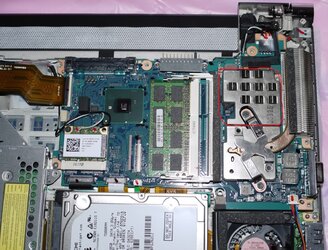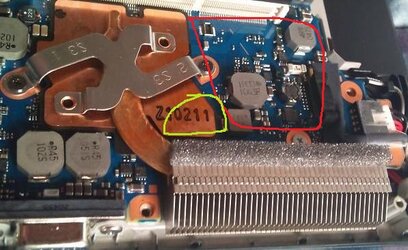- Joined
- Jan 4, 2012
Hey guys,
I have a Toshiba Portege r700-s1320. I love this little laptop, but my god does it run hot. I've got some specific questions and am looking for advice regarding a heatsink I picked up for it.
The first image you see is the factory heatsink - it is a VERY thin aluminum plate (seriously, it bends like paper). The part that is circled in red is the part in question. It doesn't appear to actually make contact with anything directly underneath it on the motherboard. I am sure the fins (the raised notches you see) are there to improve cooling. Keep that in mind as you look at picture two. This is a picture of the heatsink they shipped on the portege r835 model (newer version of mine). It shipped with a copper plate that is probably double the thickness of my aluminum one, but it doesn't have that extra area with the raised fins like the aluminum one.
The reason for this thread is I'm wondering you guys think it will be worth it to try and install the copper sink? The green circle is an area I would have to cut off of the copper plate to make it fit on my laptop. What is a good tool to cut copper like that without bending it?
Last question is regarding TIM installation. So far I've done two applications of just putting a small amount in the center of the CPU and letting the heatsink pressure spread it - is it better to spread it manually on mobile intel chips?
I have a Toshiba Portege r700-s1320. I love this little laptop, but my god does it run hot. I've got some specific questions and am looking for advice regarding a heatsink I picked up for it.
The first image you see is the factory heatsink - it is a VERY thin aluminum plate (seriously, it bends like paper). The part that is circled in red is the part in question. It doesn't appear to actually make contact with anything directly underneath it on the motherboard. I am sure the fins (the raised notches you see) are there to improve cooling. Keep that in mind as you look at picture two. This is a picture of the heatsink they shipped on the portege r835 model (newer version of mine). It shipped with a copper plate that is probably double the thickness of my aluminum one, but it doesn't have that extra area with the raised fins like the aluminum one.
The reason for this thread is I'm wondering you guys think it will be worth it to try and install the copper sink? The green circle is an area I would have to cut off of the copper plate to make it fit on my laptop. What is a good tool to cut copper like that without bending it?
Last question is regarding TIM installation. So far I've done two applications of just putting a small amount in the center of the CPU and letting the heatsink pressure spread it - is it better to spread it manually on mobile intel chips?
Attachments
Last edited:

